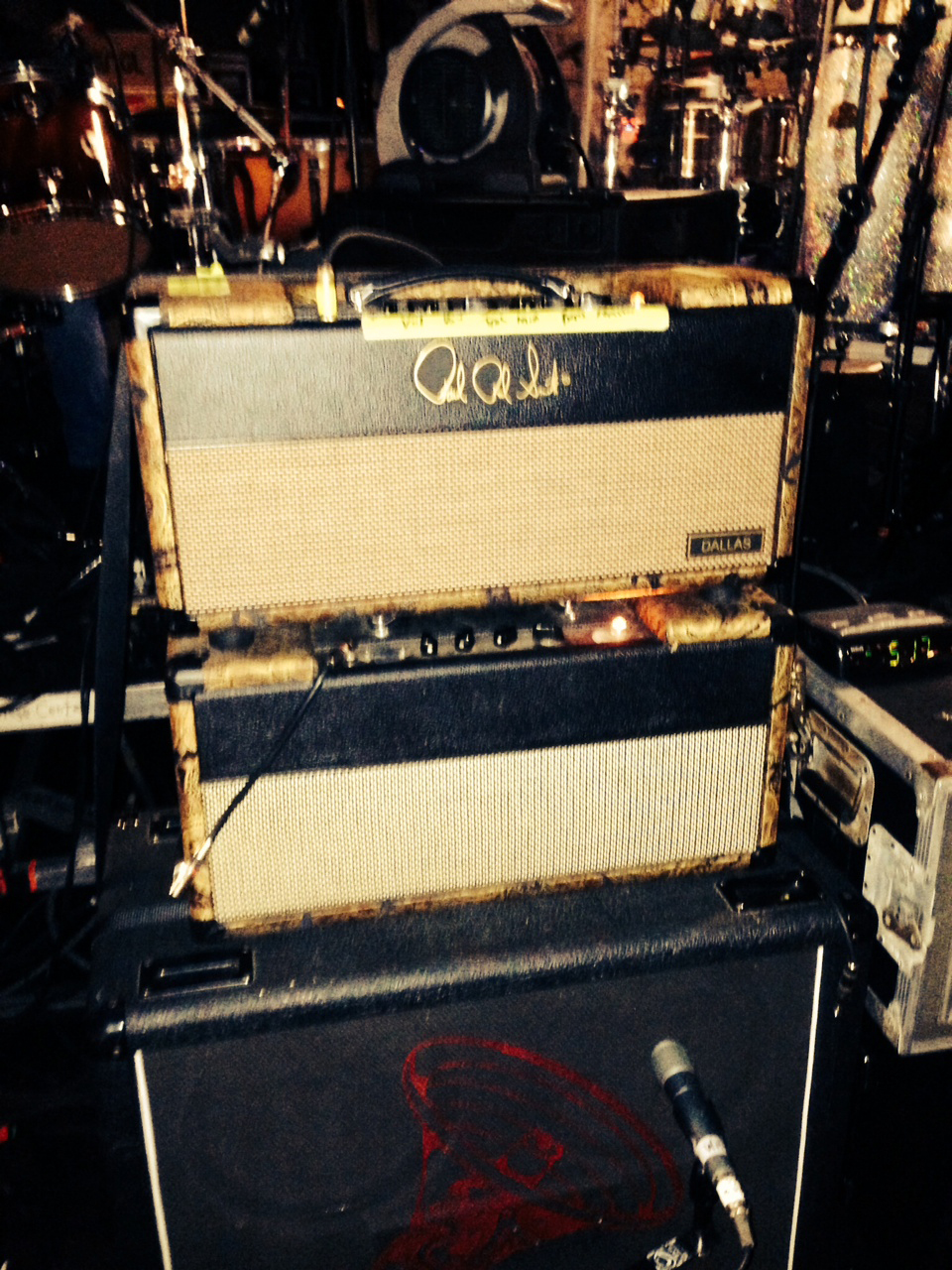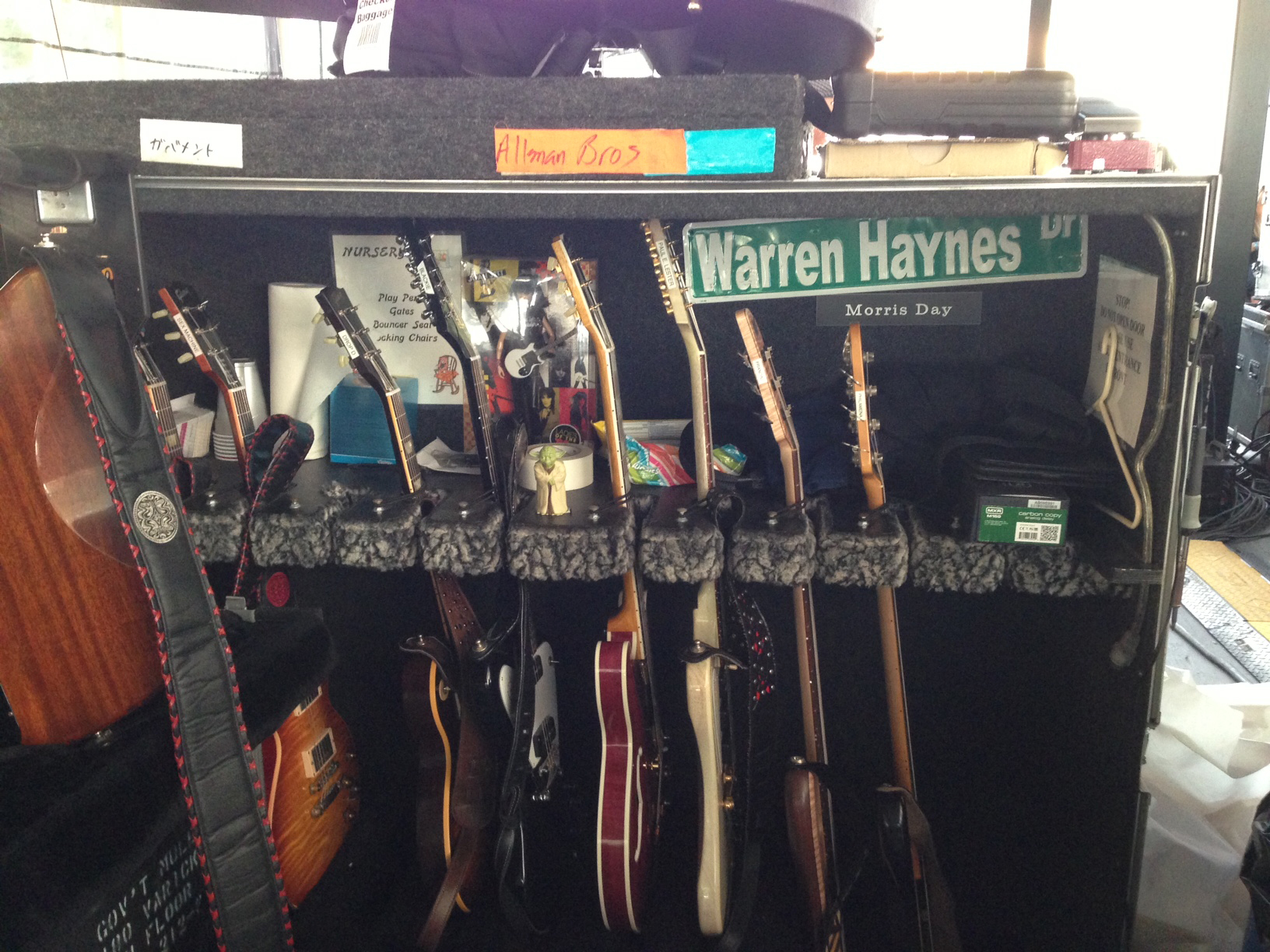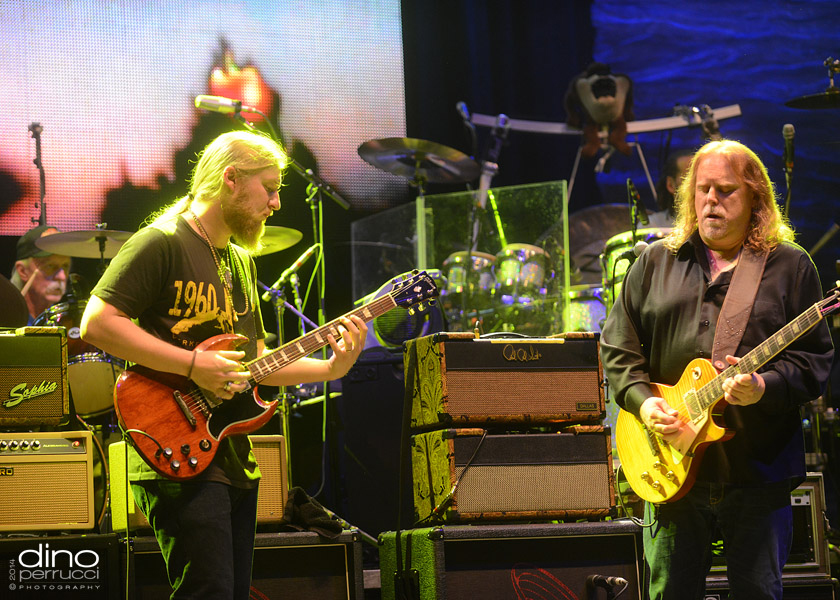
The Allman Brothers Band played 10 nights at New York City's Beacon Theatre before having to postpone their final four shows of the run due to Gregg Allman’s ongoing struggle with bronchitis.
They played the final two nights, Friday and Saturday, March 21 and 22, without Allman.
Throughout the run, guitarists Derek Trucks and Warren Haynes, who have announced that they will no longer tour with the band after this year, were front and center.
Both guitarists use different rigs with the Brothers than they do on their own, in the Tedeschi Trucks Band and Gov’t Mule, respectively.
Duane Allman’s 1959 tobacco sunburst Gibson Les Paul was on the way from Cleveland’s Rock and Roll Hall of Fame, courtesy of Duane’s daughter, Galadrielle, who owns the instrument. Trucks and Haynes were planning on playing it March 28 and 29, two of the cancelled shows. The plan was for each guitarist to play it one set per night, both nights.
I visited with guitar techs Brian Farmer (Haynes and bassist Oteil Burbridge) and Bobby Tis (Trucks) before the March 21 show for a look at the gear on an otherwise abandoned Beacon stage. Both musicians utilize rigs that are beautiful in their simplicity.
WARREN HAYNES
All the latest guitar news, interviews, lessons, reviews, deals and more, direct to your inbox!
Haynes played through two amps: a PRS Super Dallas with reverb and a Sewell Texi Plex without reverb. The latter was designed and built by Doug Sewell, who now works for PRS. Virtually the same amp is now available through PRS. Both amps feed into a Marshall 4x12 cabinet with Vintage 30 speakers.
Haynes also has a 100-watt Ampeg BA 115 cross stage bass amp that feeds Oteil Burbridge’s bass lines behind him. “He likes to really hear and feel the bass,” Farmer says.
Haynes primarily played a few different Gibson Les Pauls and 335s at the Beacon. His most-played Les Paul was “Chester,” a Gibson Custom Shop Warren Haynes model with a '59 neck, a '58 body and Gibson Burstbucker pickups. For a few songs in drop-D tuning, he played “Dee,” a '58 reissue with Burstbuckers. He also played “Big House,” a 1959 Les Paul owned by the Big House Museum in Macon, Georgia.
Haynes also played two 335s: “Huddie,” a new Gibson Memphis Warren Haynes model, which is a copy of his ‘61 335, which he no longer takes on the road, and “Blondie,” a ’59 reissue. He also sometimes plays a Zagler ES, which is custom made by Austrian builder Paul Zagler.
The guitars are strung with GHS burnished nickel strings, .10-.46. “The only exception is Dee, where we use GHS Nickel Rockers, and I change the .46 to a .54,” Farmer says.
Haynes’ Allman Brothers pedal board is extremely minimalist. With Gov’t Mule, he utilizes at least 10 pedals, but the with the ABB, he has only an Ernie Ball volume pedal into a GLab Warren Haynes model Wowee Wah into a Palmer Tri Line A/B switch to alternate amps.
“His Allman Brothers band setup is simple and effective,” Farmer says. “He gets most of his tonal variation by alternating guitars and amps, as well as pickups.”
The band’s guest amp, which was used this run by Jimmy Vivino, Gregg Allman Band guitarist Scott Sharrard, bluesman Junior Mack, Devon Allman and others, is a PRS Dallas labeled Charlie, for Trucks’ son, and run through a PRS 4x12 cab with Vintage 30s.
DEREK TRUCKS
Derek Trucks’ main guitars are two Gibson Custom Shop Dickey Betts “From One Brother to Another” model SGs, which are based on the 1961-62 SG Betts gave to Duane Allman and both played in the original ABB..
Trucks also played a sunburst Les Paul, which is a ’53 converted to a ’59 electronically and borrowed from a New York collector.
Trucks’ rig is a model of simplicity. Like Haynes, he runs through two amp heads: a PRS model HXDA, which Tis describes as a combination of a Marshall Super Lead and Super Bass; and an Alessandro, which Tis says is similar to a beefed-up 1959 Fender Twin. “It has a really clean and clear David Gilmour-type sound,” Tis says.
The Allesandro has reverb, but the PRS does not, so before hitting the amp, Trucks’ guitar runs through a 1963 Fender Reverb unit. The amps run into a Randall 4x12 cabinet with Custom Eminence speakers.
The only other thing in Trucks’ signal chain is a Radial Tone Bone switching pedal and a TC Electronic PolyTune tuner.
“He doesn’t like thinking there is anything between him and his amp,” Tis says. “It’s guitar-tuner-reverb-amp-done. Even his cable and tuner have been carefully selected to have no noise. “
OTEIL BURBRIDGE
Bassist Burbridge plays only two instruments: a Road Worn Fender P Bass with a Jazz Bass pickup added — and a six-string Fodera. He plays through two Epifani bass rigs. “They’re American made and based in Long Island, and Oteil loves them,” Farmer says.
Photo gallery: All photos by Alan Paul except where indicated.
Alan Paul is the author of the best-selling book One Way Out: The Inside History of the Allman Brothers Band.







Alan Paul is the author of four books, including Brothers and Sisters: The Allman Brothers Band and the Inside Story of the Album That Defined '70s as well as Texas Flood: The Inside Story of Stevie Ray Vaughan and One Way Out: The Inside Story of the Allman Brothers Band – both of which were both New York Times bestsellers – and Big in China: My Unlikely Adventures Raising a Family, Playing the Blues and Becoming a Star in Beijing, a memoir about raising a family in Beijing and forming a Chinese blues band that toured the nation. He’s been associated with Guitar World for 30 years, serving as managing editor from 1991 to 1996. He plays in two bands: Big in China and Friends of the Brothers (with Guitar World’s Andy Aledort).

